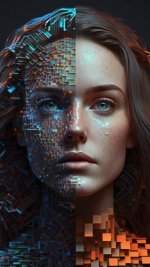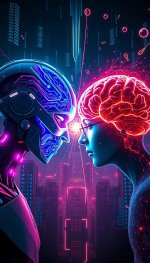Is AI Replacing Human Creativity?
Have you noticed how AI is suddenly everywhere?
It writes poems, makes pictures, answers questions, and even helps people write emails or plan trips. Some people find it super cool. Others feel a bit scared — especially creative folks who wonder, “What happens to our skills if AI can do it all?”
That’s a fair question. And it’s something worth talking about.
What AI Can Do (And Why People Are Impressed)
Let’s be real — AI tools are helpful.
You give them a few words, and they come up with a full paragraph. You describe an image, and they draw it for you. That’s powerful. You don’t need to be a writer, designer, or musician to make something anymore. All you need is a prompt.
This makes things easier, faster, and sometimes even better. People use it for blogs, college work, business ads, or just for fun. It saves time and helps when you're stuck.
But does that mean AI is actually creative?
Creativity Is More Than Just Making Things
Sure, AI can put words together. It can draw or sing or write stories. But let’s not forget something important:
Real creativity comes from real experiences.
A person writes a song about heartbreak because they’ve felt it.
An artist paints something wild because they’re expressing emotion.
A poet uses simple lines to say something deep — because it means something to them.
AI doesn’t have emotions. It doesn’t know what love feels like, or what it’s like to fail, or how it feels to miss someone. It can copy the style, but it doesn’t understand the feeling behind it.
That’s the big difference.
What Makes Human Work Special
When we create, we’re not just trying to make something that looks good. We’re telling stories, sharing feelings, and sometimes even healing ourselves.
Think of a song that made you cry, or a painting that made you stop and stare. The reason you connected with it wasn’t just because it was “perfect.” It was because it felt real.
AI can give you clean, polished results. But humans give you messy, emotional, imperfect, beautiful work — and that’s what hits the heart.
So... Should We Stop Using AI?
Not at all.
AI isn’t the enemy. In fact, it can be a great tool if we use it right. It can help us start a draft, give us ideas, or show us new styles. Many writers and artists already use AI to support their work — not to replace it.
Think of it like this:
The calculator didn’t replace math teachers.
The camera didn’t end painting.
Spotify didn’t stop people from writing songs.
New tools just change how we work — they don’t take away the need for human ideas.
The Future: AI + Humans Together
The best creations will probably come from both: humans + AI working together.
You bring the thoughts, the emotions, the story. AI helps you shape it, build it faster, or improve it.
And that’s okay.
Creativity isn’t going anywhere. People will always have things to say, stories to tell, and feelings to express. That can’t be replaced — not even by the smartest machine.
Final Words
So, is AI replacing human creativity?
Not really. It’s changing the tools we use, but not the reason we create.
As long as people feel, think, and dream — creativity will always be ours. Written by Sastika Rai- a content writer who believes real thoughts speak louder than perfect words.
Have you noticed how AI is suddenly everywhere?
It writes poems, makes pictures, answers questions, and even helps people write emails or plan trips. Some people find it super cool. Others feel a bit scared — especially creative folks who wonder, “What happens to our skills if AI can do it all?”
That’s a fair question. And it’s something worth talking about.
What AI Can Do (And Why People Are Impressed)
Let’s be real — AI tools are helpful.
You give them a few words, and they come up with a full paragraph. You describe an image, and they draw it for you. That’s powerful. You don’t need to be a writer, designer, or musician to make something anymore. All you need is a prompt.
This makes things easier, faster, and sometimes even better. People use it for blogs, college work, business ads, or just for fun. It saves time and helps when you're stuck.
But does that mean AI is actually creative?
Creativity Is More Than Just Making Things
Sure, AI can put words together. It can draw or sing or write stories. But let’s not forget something important:
Real creativity comes from real experiences.
A person writes a song about heartbreak because they’ve felt it.
An artist paints something wild because they’re expressing emotion.
A poet uses simple lines to say something deep — because it means something to them.
AI doesn’t have emotions. It doesn’t know what love feels like, or what it’s like to fail, or how it feels to miss someone. It can copy the style, but it doesn’t understand the feeling behind it.
That’s the big difference.
What Makes Human Work Special
When we create, we’re not just trying to make something that looks good. We’re telling stories, sharing feelings, and sometimes even healing ourselves.
Think of a song that made you cry, or a painting that made you stop and stare. The reason you connected with it wasn’t just because it was “perfect.” It was because it felt real.
AI can give you clean, polished results. But humans give you messy, emotional, imperfect, beautiful work — and that’s what hits the heart.
So... Should We Stop Using AI?
Not at all.
AI isn’t the enemy. In fact, it can be a great tool if we use it right. It can help us start a draft, give us ideas, or show us new styles. Many writers and artists already use AI to support their work — not to replace it.
Think of it like this:
The calculator didn’t replace math teachers.
The camera didn’t end painting.
Spotify didn’t stop people from writing songs.
New tools just change how we work — they don’t take away the need for human ideas.
The Future: AI + Humans Together
The best creations will probably come from both: humans + AI working together.
You bring the thoughts, the emotions, the story. AI helps you shape it, build it faster, or improve it.
And that’s okay.
Creativity isn’t going anywhere. People will always have things to say, stories to tell, and feelings to express. That can’t be replaced — not even by the smartest machine.
Final Words
So, is AI replacing human creativity?
Not really. It’s changing the tools we use, but not the reason we create.
As long as people feel, think, and dream — creativity will always be ours. Written by Sastika Rai- a content writer who believes real thoughts speak louder than perfect words.


